Chris Grinter, 25. srpnja, 2011 Ovaj ponedjeljak sam odstupio od ustaljene Arctiinae za nešto potpuno drugačije – microlep! To je Nepticulidae, Stigmella diffasciae, i to u mjeri u nevjerojatnih 6 mm. Ja ne mogu preuzeti zasluge za širenje ovog savijača – sve nepticulids sam fotografirali su iz Kalifornije akademije znanosti i širiti Dave Wagner, dok je on bio ovdje za postdoctorate poziciju.
U gusjenice mina gornje strane lišća Ceanothus i poznati su samo iz podnožju Sierra Nevade u Kaliforniji. Ako ste tako sklon reviziju od sjevernoameričkih vrsta roda je slobodno dostupan ovdje (.pdf).
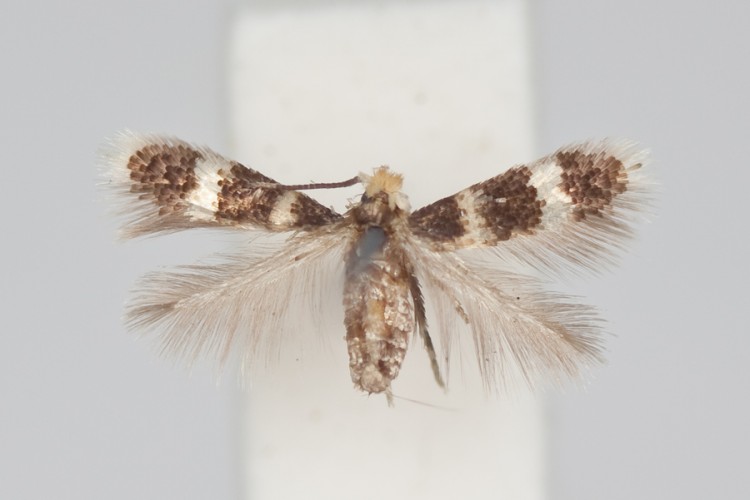 Stigmella diffasciae (Nepticulidae)
Chris Grinter, 22. srpnja, 2011 It’s been a little while since the last GOP challenge, ali this is a softball. I’m hoping they were just too lazy to find a more suitable image…

Chris Grinter, on July 19th, 2011 What would Jesus do if he had some free time – maybe cure a disease, end a war, or feed the starving – but nah, everyone sees that coming. Why not shock them to the core – burn your face on a Walmart receipt! Barem, that’s what a couple in South Carolina believe to have found, a Walmart receipt with Jesus’s face on it. This isn’t exactly new or exciting, humans have a wonderful ability to recognize a face in just about anything. Jesus and other characters “appear” on random things all the time, and even in 2005 a shrine was built to the Virgin Mary around a water stain in a Chicago underpass.
Pareidolia anyone? Zapravo, that face looks pretty convincing, I’m not too sure this wasn’t just faked or “enhanced”. The closeups even look like there are fingerprints all over it. Since I don’t have a walmart anywhere near me or a walmart receipt on hand I can’t determine how sensitive the paper is and how easy it would have been to do – but how long do you think before it shows up on ebay? U svakom događaju, it looks much more like James Randi to me than Jesus (at least we actually know what Randi looks like!).
 from CNN
Chris Grinter, on July 18th, 2011 Preko Arthropoda, kolega SFS bloger Michael Bok podijelio je sliku svog prijatelja na terenu, Uključite zelenu žabu. Moja prva pomisao bila je na sličnu žabu uklet dočekao me gdje god sam otišao u Nacionalni park Santa Rosa, Kostarika. Nepotrebno je reći, Kostarika usađuje iznenadnu naviku dvostruke provjere sve što namjeravate učiniti. Ova vrsta je poznata kao mliječna žaba (Phrynohyas venulosa) zbog obilnih količina mliječnobijelih otrovnih izlučevina. Jedna od prvih priča koje mi je Dan Janzen ispričao dok sam bio s njim u Santa Rosi bila je o ovoj vrsti – i slučajno protrljao oko nakon što ga je držao. Srećom sljepoća i pečenje bila samo privremena.
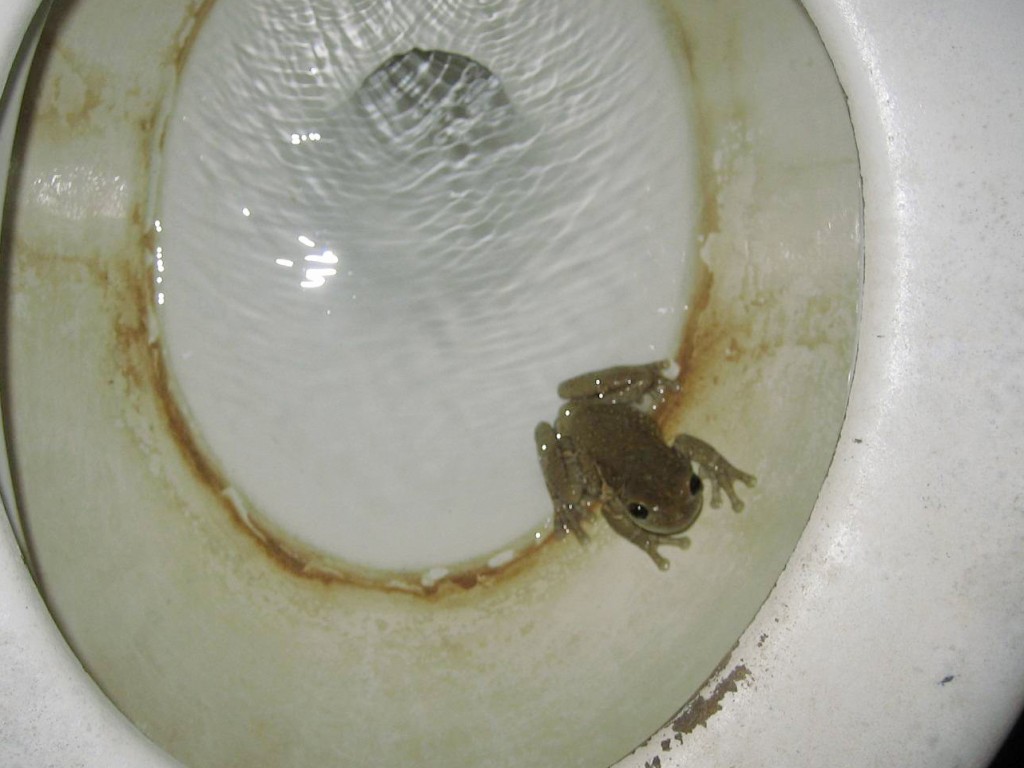 Mliječna žaba: Phrynohyas venulosa
Chris Grinter, on July 18th, 2011 I’ll keep the ball rolling with Arctiinae and post a photo today of Ctenucha brunnea. This moth can be common in tall grasses along beaches from San Francisco to LA – although in recent decades the numbers of this moth have been declining with habitat destruction and the invasion of beach grass (Ammophila arenaria). But anywhere there are stands of giant ryegrass (Leymus condensatus) you should find dozens of these moths flying in the heat of the day or nectaring on toyon.
 Ctenucha brunnea (Erebidae: Arctiinae)
Chris Grinter, on July 12th, 2011 Well as you may have guessed the subject isn’t as shocking as my title suggests, but I couldn’t help but to spin from the Guardian article. I really find it hilarious when I come across anything that says scientists are “astounded”, “baffled”, “shocked”, “puzzled”, – I guess that’s a topic for another time… Nevertheless a Stvarno cool butterfly has emerged at the “Sensational Butterflies” exhibit at the British Museum in London – bilateralna gynandromorph! The Guardian reports today that this specimen of Papilio memnon just emerged and is beginning to draw small crowds of visitors. I know I’d love to see one of these alive again – although the zoo situation would take away quite a bit of the excitement. I think the only thing more exciting than seeing one of these live in the field would be to net one myself!
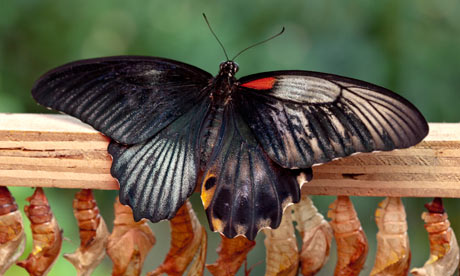
One little thing tripped my skeptical sensors and that is the quote at the end of the article taken from the curator of butterflies, Blanca Huertas. “The gynandromorph butterfly is a fascinating scientific phenomenon, and is the product of complex evolutionary processes. It is fantastic to have discovered one hatching on museum grounds, particularly as they are so rare.”
Dobro, I don’t specifically see how these are a “product of … evolutionary processes” inasmuch as svi life in svi forms is a product of evolution. These are sterile “glitches” that are cool, but not anything that has been specifically evolved for or against. Perhaps it would be more adept to call this a fascinating process of genetics (which the article actually describes with accuracy). Također – butterflies emerge as adults and hatch as caterpillars – but that’s just me being picky.
Chris Grinter, on July 11th, 2011 Today’s moth is a beautiful and rare species from SE Arizona and Mexico: Lerina incarnata (Erebidae: Arctiinae). Like many other day flying species it is brilliantly colored and quite likely aposematic. After all, the host plant is a milkweed and the caterpillar is just as stunning (ispod).
 Lerina incarnata (Erebidae: Arctiinae)
This image of an old, spread specimen hardly does the animal justice, but one lucky photographer found a female ovipositing at the very top of a hill outside of Tucson, Arizona. While you’re at it go check out some of Philip’s other great photographs on SmugMug.
 Lerina incarnata - Philip Kline, BugGuide As I mentioned above this moth also has an equally impressive caterpillar that feeds on Ascleapias linaria (pineneedle milkweed).
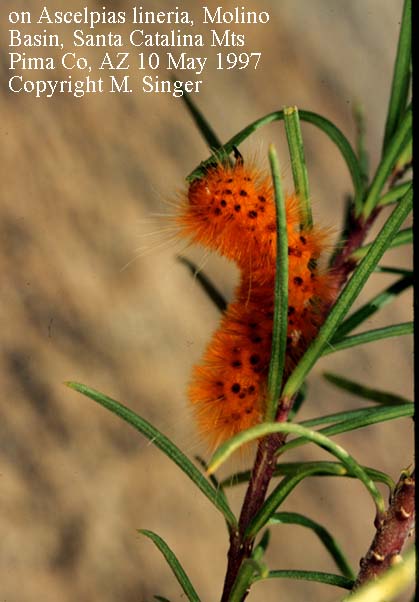
Chris Grinter, 5. srpnja, 2011 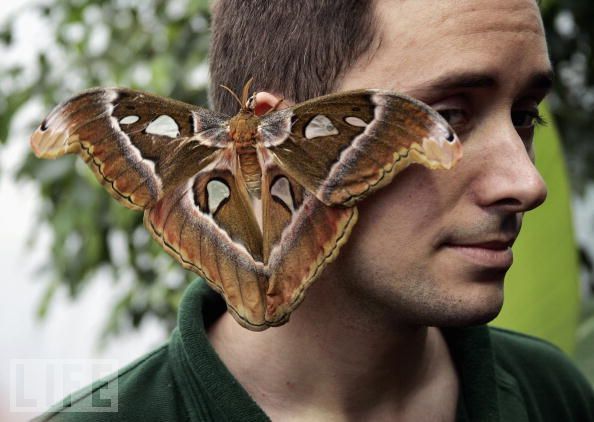
Čini se kao da prevladavaju urbane legende koje uključuju kukce koji nam se uvlače u lice dok spavamo. Najpoznatiji mit je nešto nalik na “ti jedeš 8 pauci godišnje dok spavaju“. Zapravo kada proguglate taj broj se kreće od 4 do 8… do jedne funte? Nije iznenađujuće da se stvari na internetu tako preuveličavaju, posebno kada je u pitanju sve popularna arahnofobija. Sumnjam da prosječni Amerikanac pojede više od nekoliko pauka tijekom cijelog svog života; vaš dom jednostavno ne bi trebao biti pun toliko pauka da vam svake noći završe u ustima! Sličan mit je još uvijek mit, ali sa zrnom istine – da ti se ušice noću zarivaju u mozak da bi polagale jaja. Nije istina da su ušice ljudski paraziti (zahvaljujući), ali imaju predispoziciju da se zavuku u tijesno, vlažna mjesta. Moguće je da je to bila dovoljno česta pojava u Ye Olde England da je ušica zaslužila ovo zloglasno ime. Žohari su također dokumentirani kao ušnici – ali svaki kukac puzav koji bi mogao hodati po nama noću bi mogao završiti u jednom od naših otvora.
Međutim, nikad nisam čuo da se moljac uvukao u uho dok nisam naišao ovu priču danas! Pretpostavljam da je zbunjeni Noctuid nekako završio u uhu ovog dječaka, iako se ne mogu ne zapitati je li ga on sam stavio tamo… Moljci obično ne slijeću na ljude dok spavaju niti su skloni da pronađu vlagu, uska mjesta. Ali opet je sve moguće, neki noktuidi se danju zavlače ispod kore ili lišća radi sigurnog skrivanja. Čak sam i naišao druga priča ušnog moljca iz Velike Britanije (nije da je Daily Mail ugledan izvor).
Prirodno, neki lijeni izvori vijesti su korištenjem datoteka fotografija “moljci” umjesto kopiranja fotografije iz izvorne priče. Posebno je smiješno jer je jedna od korištenih slika opis nove vrste moljca prošle godine od Brucea Walsha u Arizoni. Lithophane leeae je već dva puta istaknuta na mom blogu, ali nikad ovako!
Kao završnu riječ, ovdje je pjesma Roberta Cordinga (također gdje je gornja slika nađen).
Razmotrite ovo: moljac uleti čovjeku u uho
Jedna obična večer nezapaženih užitaka.
Kad moljac udari krilima, svi vjetrovi
Od zemlje se skupi u njegovo uho, urlati kao ništa
On je ikada čuo. Trese se i trese
Njegova glava, mu je žena zarila duboko u uho
S Q-vrhom, ali tutnjava neće prestati.
Čini se kao da su sva vrata i prozori
Od njegove kuće odmah su otpuhali -
Čudna igra okolnosti nad kojom
Nikada nije imao kontrolu, ali koje je mogao zanemariti
Sve dok večer nije nestala kao da jeste
Nikad to nisam živio. Njegovo tijelo više nije
Čini se svojim; vrišti od bola da se utopi
Iz vjetra u uhu, i proklinje Boga,
Tko, Satima prije, bila je benigna generalizacija
U svijetu koji ide dovoljno dobro.
Na putu do bolnice, njegova žena stane
Automobil, kaže mužu da izađe,
Da sjedim u travi. Nema auto svjetala,
Nema ulične rasvjete, nema mjeseca. Ona uzima
Svjetiljka iz pretinca za rukavice
I drži ga pokraj uha i, nevjerojatno,
Moljac leti prema svjetlu. Njegove oči
su mokri. Osjeća se kao da je iznenada postao hodočasnik
Na obali neočekivanog svijeta.
Kad legne natrag u travu, On je dječak
Opet. Njegova žena svijetli baterijskom svjetiljkom
U nebo i tamo je samo tišina
Nikad nije čuo, i mala cesta
Svjetlosti koje ide negdje gdje nikad nije bio.
– Robert Cording, Zajednički život: Pjesme (Fort Lee: CavanKerry Press, 2006), 29–30.
Chris Grinter, on June 30th, 2011 
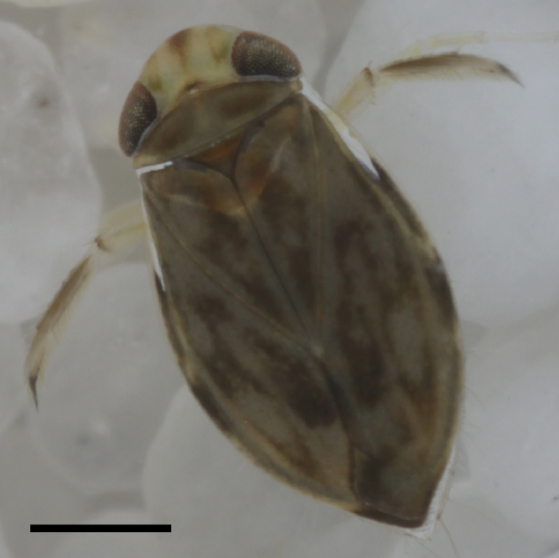 Micronecta scholtzi The hills of the European countryside are alive in the chorus of amorous, screaming, male aquatic bugs. The little insect above, Micronecta scholtzi (Corixidae), measures in at a whopping 2.3mm and yet produces a clicking/buzzing sound easily audible to the human ear above the water surface. To put that in perspective: trying to hear someone talk underwater while standing poolside is nearly impossible, yet this minute insect generates a click loud enough to be mistaken for a terrestrial arthropod. While that doesn’t sound too impressive when we are surrounded by other loud insects like the cicada, M. scholtzi turns out to be a stunningly loud animal when you take into consideration the body size and medium the sound is propagating through to reach our ear. Put into numbers the intensity of the clicks underwater can reach up to 100 dB (Sound Pressure Level, SPL). Shrink us into the insect world and this sound production is equal to a jackhammer at the same distance! So what on earth has allowed this little bug to make this noise and get away with it in a world full of predators?
The authors naturally point out how surprising these results are. The first thing that becomes apparent is that the water boatmen must have no auditory predators since they are basically swimming around making the most noise physically possible for any small animal anywhere. Really this isn’t too surprising since most underwater predators are strictly visual hunters (dragonfly larvae, water bugs and beetles etc…). It is very likely that sexual selection has guided the development of these stridulatory calls into such astounding levels. The second most surprising thing is clear once you graph just how loud these insects are relative to their body size. At the top of the graph is the bottlenose dolphin (T. truncatus) with its famous sonar. But the greatest outlier is actually our little insect in the bottom left with the very highest ratio between sound and body size (31.5 with a mean of 6.9). No other known animal comes close. It is likely though that further examination of other aquatic insects may yield similar if not more surprising results!
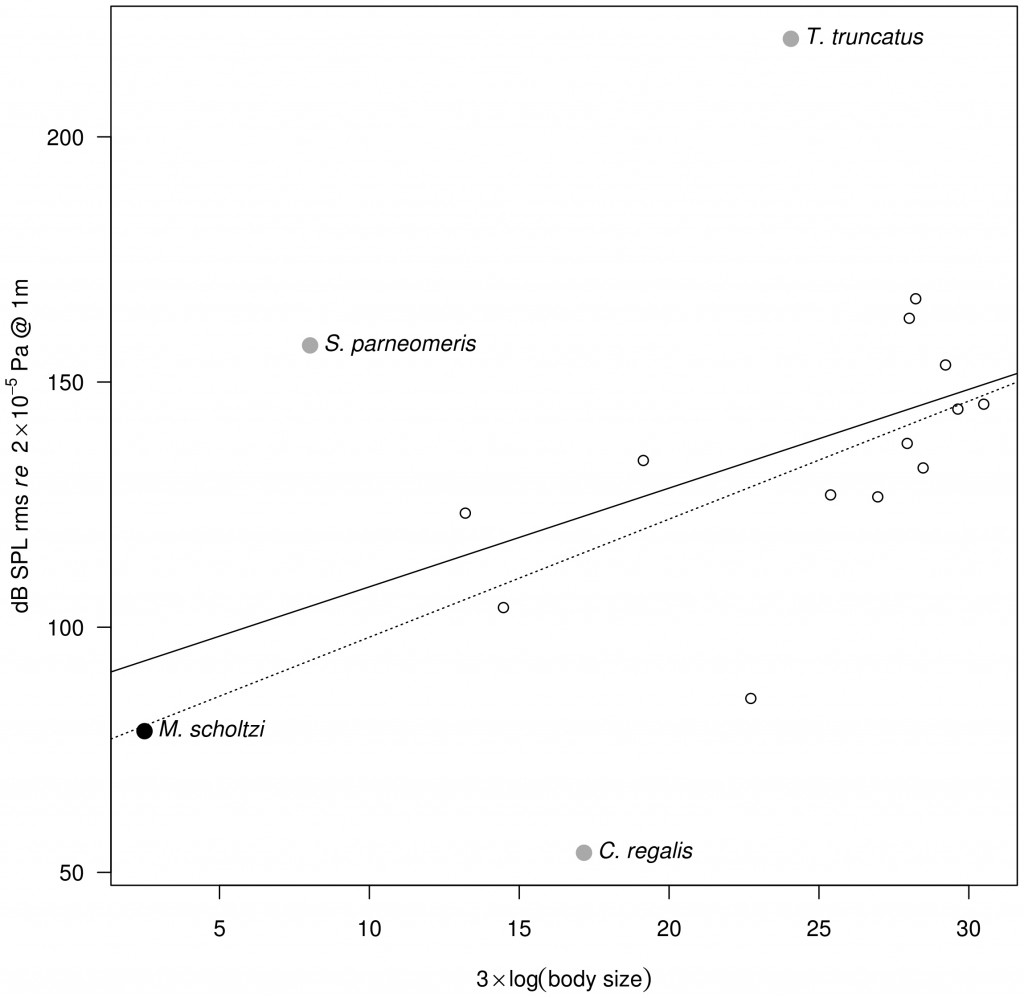
To be more accurate about the “screaming”, the bugs (bugs in this instance is correct; the Corixidae belong to the order Hemiptera – the true bugs) are likely to be stridulating – rubbing together two parts to generate sound instead of exhaling air, drumming, itd… In the article the authors speculate that the “sound is produced by rubbing a pars stridens on the right paramere (genitalia appendage) against a ridge on the left lobe of the eighth abdominal segment [15]”. Without pulling up their citation, it appears that stridulation by males in the genus is well documented for mate attraction. And as you would expect, news outlets and science journalists read “genitalia appendage” and translate that to penis: and you end up with stories like this. The function of the parameres can be loosely translated to similar to mandibles in that they are opposing structures (usually armed with hairs) for grasping. The exact use of them may differ by species or even orders, but they are very distinct form the penis (=aedeagus) since they simply help facilitate mating and don’t deliver any sperm. So in reality you have genital “claspers” s “pars stridens”. And the best illustration of a pars stridens is over on the old blog Archetype. This structure is highlighted below in yellow (and happens to exist on the abdomen of the ant). But in short – it’s a regular grooved surface akin to a washboard. In the end the sentence quoted above should be translated to “two structures at the tip of the abdomen that rub together like two fingers snapping”.
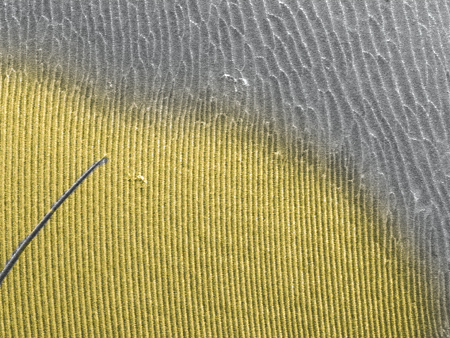 Detail of the pars stridens (in yellow) on the forth abdominal tergite in a Pachycondyla villosa worker (Scanning Electron Micrograph, Roberto Keller/AMNH) Continue reading The incredibly loud world of bug sex
Chris Grinter, 20. lipnja, 2011 Ja ću zadržati loptu valjanje u ovoj seriji i pokušati napraviti što više redovito. Također ću se usredotočiti na isticanje nove vrste svaki tjedan od golemih zbirki ovdje na California Academy of Sciences. To nam daje dovoljno materijala za… barem nekoliko stotina godina.
 Grammia edwardsii (Erebidae: Arctiinae) Ovotjedna primjerak medonjica Grammia edwardsii. Do prije nekoliko godina ova obitelj od moljaca smatralo odvojena od Noctuidae – ali nedavna molekularna i morfološka analiza pokazuje da je to u stvari Noctuid. Obitelj Erebidae je izvukao iz unutar Noctuidae i Arctiidae se stavi, pretvarajući ih u podvrstu Arctiinae. OK dosadna taksonomija zabit – sve u svemu, to je lijepa moljac i gotovo ništa ne zna o tome. Ovaj uzorak je prikupio u San Franciscu 1904 – zapravo su prikupljeni gotovo svi primjerci poznati ove vrste u gradu na prijelazu stoljeća. Iako je to moljac izgleda vrlo slično izobilju i raširena Grammia krasi, u blizini analiza očiju, oblik i antene krilo tvrde da je to zapravo zasebna vrsta. Vjerujem posljednji primjerak bio prikupljeno oko 1920-ih godina i to nije vidio od. To je vjerojatno i šteta što to može moljac su izumrle tijekom prošlog 100 godina razvoja SF Bay regiji. Grammia, i Arctiinae u cjelini, nisu poznati po visokim razinama domaćina specifičnosti; oni imaju tendenciju da se kao mala krava i hrane se gotovo sve što je u njihovom putu. Dakle, ostaje zagonetan zašto ovaj moljac ne bi imao stanište danas, čak iu grad tako jako uznemireni. Možda je to moljac specijalizirana za slanim močvarnih područja koje okružuju zaljev – koje su sve, jer je nestala zbog odlagališta za nekretnine (1/3 na cijeli zaljev je izgubila ispuniti). Ili možda ovaj moljac ostaje s nama i danas, ali se nikad ne prikuplja, jer je dvosmislen dan leti vrsta. Ja uvijek držim oči u parku u proljeće za malu naranče zamućenja…
|
Skepticizam
|














